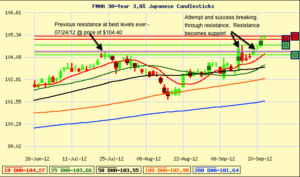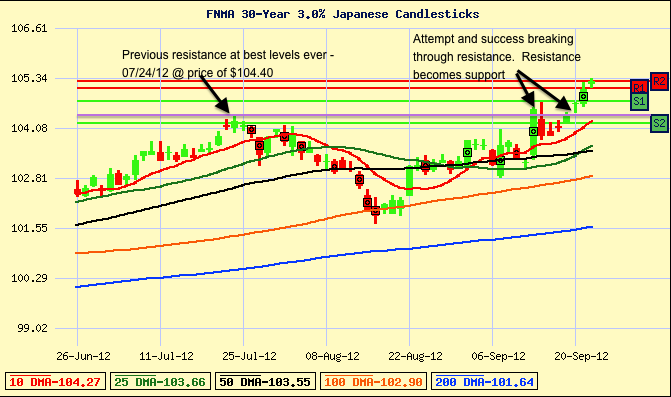Mortgage Rate and Real Estate Update – Week of 11/26/12
It’s not a cyber Monday sale, home loan rates have actually been this low for a while now. Thanks to the fiscal cliff issues and Eurozone drama being front and center, interest rates are holding strong near historic lows.
Mortgage interest rate and real estate news from last week:
- Low mortgage rates allow buyers to afford up to 20% more in home price compared to 3 years ago
- The Fall and Rise of Jumbos – Homes values with jumbo mortgages fell hard, now rising Fast
- “G-Fees” drive up loan costs across the board for some states – Texas lucky to avoid this round, for now…
- Holiday tidbit – Wanting your own ’12 Days of Christmas’? The cost this year tops $107k
In a holiday shortened trading week, home loan interest rates and mortgage bonds were mostly unchanged. News that Europe is now in the midst of its second recession in four years and the U.S. weekly jobless claims coming it at their highest level in 18 months would typically spark more volatility, but interest rates seem to be comfortable in the current trading range established over the last month near historic lows. The low volume trading and friendly Bond news allows the Fed to keep their QE3 stimulus funds available for any major volatility that may come to the markets.
What’s coming up this week on the economic calendar and what’s the impact on interest rates?
With no major economic reports due for release this week, most attention will be placed on talks of a lawmakers reaching a resolution on the fiscal cliff issues. The markets will also be closely watching a meeting of finance ministers in the Eurozone as they digest news of the recession. The battle grows deeper as major Euro countries like Germany, refuse to participate in further “bail-outs” of Greece unless they can make further budget cuts and commit to repay some of their debt.
In the midst of the global economic soap opera, the Treasury will be auctioning off $99 Billion in Notes this week. Depending on the investor appetite of the 2, 5, and 7 year Note auctions, we could see volatility creep back into the Bond markets. On the flip side, should the auction go well, the S&P 500 could slip further from its 200 day moving average, allowing home loan rates to move closer to all time lows.
Here’s our strategy for the days and weeks ahead…
Interest rates for home loans have found a comfortable trading range over the last 30 days and have managed to create a solid level of support just beneath current levels. As long as mortgage Bonds can manage to remain above this key technical support, interest rates have a great chance to rally and move closer to all time lows for interest rates. Our advice would be to float in the near term unless something changes, causing pricing to break through support. With the amazingly low interest rates available to homeowners and home buyers, the time is now to consider their options for a refinance or start their planning for a home purchase.
We maintain an ongoing dialogue with our clients about the market and interest rates throughout their financing experience so we can take advantage of the lowest rates when they present themselves. We all want the lowest rate, and the best way to ensure that you get the lowest rate, is to build a relationship with your mortgage planner, so they can best advise you on when to lock in your rate. Call us today for a complimentary mortgage review or Apply Online.
Current Interest Rates – Week of 9/24/12
Mortgage backed securities continue to paint the record books with the help of QE3 and the Fed’s attempt to further stimulate the economy. Find out why Robert Shiller from the Case/Shiller Home Price Index says that he feels that mortgage interest rates will not fall much further from their current levels. Is this the best rates are going to get?
What happened with interest rates last week?
Home loan interest rates managed to find their way back to all time lows last week as the Bond markets started their rally based on weak economic data out of Asia and Europe and the continued Bond buying from the Fed and the QE3 stimulus. The Fed is currently purchasing $40 billion of mortgage backed securities each month and could not have ho ped for better results in the first full week of the stimulus. Mortgage backed securities have risen by over 125 basis points, leading to our lowest interest rates ever. Aside from the weak economic data out of Asia and Europe, Initial Jobless Claims came in higher than expected at a number of 382,000.
ped for better results in the first full week of the stimulus. Mortgage backed securities have risen by over 125 basis points, leading to our lowest interest rates ever. Aside from the weak economic data out of Asia and Europe, Initial Jobless Claims came in higher than expected at a number of 382,000.
From a technical standpoint, we’re painting a new picture going forward. Mortgage backed securities have broken through all previous resistance levels established back on July 24th, 2012, our previous all time highs. As a result of breaking through resistance, these levels now will act as a floor of support, highlighting a new “worst case” pricing for home loans closing in the near term.
What’s coming up this week on the economic calendar and what’s the impact on interest rates?
The economic calendar is packed with releases this week. Starting on Tuesday with the Case-Shiller Home Price Index and Consumer Confidence, New Home Sales on Wednesday and Initial Jobless Claims on Thursday, the markets should continue their current trend leading into the big news on Friday. The Friday reports will start off with the Core Personal Consumption Expenditures, the Fed’s favorite gauge of inflation, which measures price changes in consumer goods and services after excluding food and energy components. Since inflation has a direct impact on interest rates, the report will be monitored to see if the year-over-year inflation figure has increased from its previous level of 1.6%. Also schedule for release on Friday is the Chicago PMI. Also known as the “Business Barometer”, the Chicago PMI is a manufacturing report indicating what may be to come in the ISM survey that will be released the following business day.
Here’s our strategy for the days and weeks ahead…
The stage is set for home loan rates to drop to the lowest levels we may see in our lifetime. Mortgage backed securities have broken through nearly all resistance levels, weak economic news continues to flow out of Europe and Asia, QE3 is in full swing. What more could we ask for?
Robert Schiller of the Case-Schiller Home Index expects that mortgage rates will not fall much further from their current levels. Here are a few reasons why:
- High Loan Volume = Higher Rates – The home purchase markets are continuing to gain traction as home prices stabilize and interest rates set historic lows. Throw in the numerous refinance programs available to current home owners and you’ll find lenders across the board are as busy as they have been in years. When loan volume increases and lenders start to reach capacity, they reach a breaking point. Beware of the bigger Banks like Wells Fargo, Chase, Bank of America, Citi, etc. Turn times are likely to get extended to a point that the applications are not able to close for 60-90+ days. As a result, their interest rates may be adjusted higher to slow down incoming applications. Smaller Banks and lending institutions (ie. Brazos National Bank) can avoid some of these issues with streamlined underwriting and closing processes.
- “G-Fee” – The “g-fee” or Guarantee fee has been implemented twice in the past 12 months and is a charge on all Fannie Mae and Freddie Mac home loans. The fee equates to roughly 75 basis points in price adjustment and is designed to raise revenues for Fannie/Freddie in an attempt to privatize the government sponsored entities. The previous “g-fee” was announced less than 3 weeks ago, and is now being followed by a third round of “g-fees”, targeting New York, Florida, Connecticut, New Jersey and Illinois. Follow the link to read FHFAs notice.
As the Guarantee fees mandated by FHFA continue to accrue and big Banks run at max capacity, the QE3 stimulus can only do so much to drive down home loan rates. A disconnect will start to form between the price of mortgage backed securities and the actual home loan interest rates that are offered to consumers.
Home loan rates have never been this low and may not stay this low for long. We are advising our clients to lock in their interest rate in the near term to take advantage of today’s low rates. In the longer term, we may see rates go lower, but there are too many other factors that can’t be solved by money printing (QE3), that are likely to send rates higher.
We maintain an ongoing dialogue with our clients about the market and interest rates throughout their financing experience so we can take advantage of the lowest rates when they present themselves. We all want the lowest rate, and the best way to ensure that you get the lowest rate, is to build a relationship with your mortgage planner, so they can best advise you on when to lock in your rate. Call us today for a complimentary mortgage review or Apply Online.

